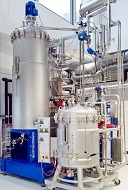
Carbon dioxide (CO2) recycling is a possibility to decrease greenhouse gas emissions. Acetogenic microorganisms are able to reduce CO2 using hydrogen gas (H2), or carbon monoxide (CO) is converted to organic acids and alcohols directly.
Electron transfer via a cathode, covered with a biofilm of acetogenic bacteria, has already been demonstrated for CO2 reduction. However, the need for a large cathode area complicates the technical implementation. Simultaneous reduction of CO2 and water to CO and H2 in a bioelectrochemical system (BES) with suspended acetogenic microorganisms represents an interesting alternative, since less cathode area is required. The initial ‚two-dimensional‘ process with a biofilm on a cathode would be transformed to a ‚three-dimensional‘ process then.
This research project focuses on the establishment of a novel bioelectrochemical system to reduce CO2 electrocatalytically. In this system, the electron-transporters H2 and CO are produced in the cathode chamber and consumed by acetogenic microorganisms together with CO2 for alcohol production. The novel electrocatalyst integrated into a membrane-electrode-assembly is provided by project partners. In regards of electrocatalytical-microbial CO2 conversion, the process will be characterized using selected acetogenic microorganisms in order to find optimal reaction conditions. The identification of appropriate operation points will deliver fundamental data to evaluate the system’s efficiency.
This research project is financially supported by the priority program eBiotech (SPP2240) of the German Research Foundation (DFG).
Publications
- Schwarz I, Angelina A, Hambrock P, Weuster-Botz D (2024): Simultaneous formate and syngas conversion boosts growth and product formation by Clostridium ragsdalei. Molecules 29: 2661.
- Schwarz I, Rieck A, Mehmood A, Bublitz R, Bongers L, Weuster-Botz D, Fellinger T-P (2024): PEM electrolysis in a stirred-tank bioreactor enables autotrophic growth of Clostridium ragsdalei with CO2 and electrons. ChemElectroChem 11: e202300344.